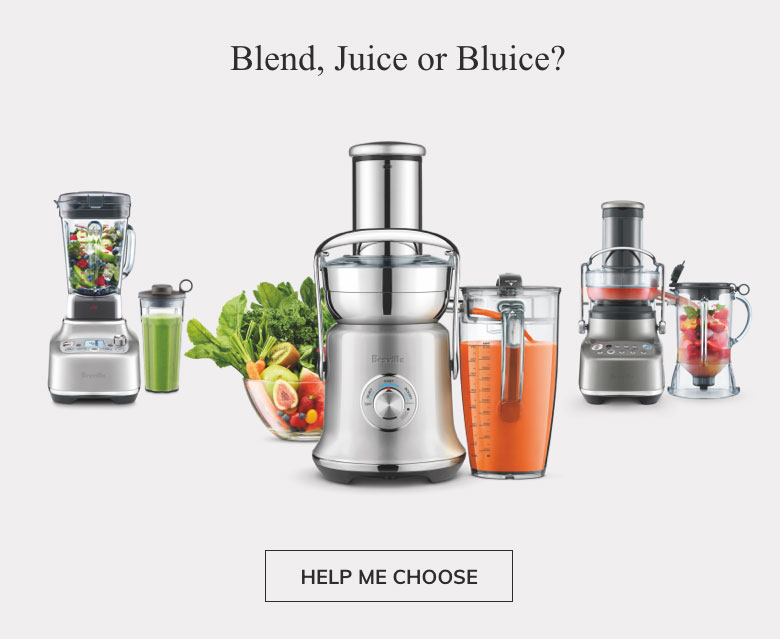Five Ways to Juice
A guide to choosing the right juicer for you, and making
the most of it once it’s on your counter.
KEY FEATURES
Low heat: Foods juiced in a slow juicer are
heated less in the juicing process, which helps
retain nutrients.
Less oxidation: Less air is incorporated during
the juicing process, which means less foam in
your juice and a longer shelf life for the juice.
Extra fiber: Slow juicers produce. Thicker juice
that retains more fiber from the original food
than juice yielded at a high speed.
Wheatgrass-friendly: All leafy greens can be
slow juiced, including wheatgrass.
Approved for nuts: If almond milk is your
thing, slow juicing is the only method that
can be used.
Quieter process: No blades and no high-speed
spinning means less noise.
Smaller size: Most slow juicers take up very
little counter space, though the smaller size
also requires a bit of prep in cutting down
ingredients to fit into the feed tube.
Blade free: No blades are involved in the
juicing process, so you don’t’ have to handle
anything sharp during cleanup.
KEY FEATURES
Speed: The faster process makes a
high-speed juicer a great fit if you make juice
for four or more people at a time.
Less prep: Many foods don’t require any prep
prior to juicing. For example, whole apples can
be juiced.
Less pulp: Juice from la high-speed juicer is
great for people who prefer minimal pulp
in their juice, though the fiber content is lower.
Leafy greens: Though high-speed juicers can
handle leafy greens like spinach and kale, they
cannot juice wheatgrass.
Sound: After the food is placed in the food
tube, the sound should be comparable to a
blender on its highest setting.
Shelf life: Because high-speed juicing exposes
food to more air, it’s a good fit for people who
tend to drink their juice right away, as the juice has a shorter shelf life.
KEY FEATURES
Low heat: The Cold Spin Technology spins
fresh ingredients at a low temperature for the
highest possible juice yield while preserving
the most nutrients.
Max versatility: Make traditional smoothies or
juices, or try frappes, slushies and frozen
cocktails made with freshly juiced ingredients,
all in one machine.
Little prep: The extra-wide 3 1/2" feed chute
accepts whole fruits and vegetables without
pre-cutting.
Countertop savings: Since the machine can
double as a juicer or a blender, it can play the
role of two appliances, with the countertop
space of just one.
KEY FEATURES
Speed: The fastest method, whole-food juicing
takes a fraction of the time of traditional juice
making.
The most fiber: Liquid and pulp are not
separated, so juice is high in pulp and contains
the ingredients’ full fiber content.
Cursory prep: Anything that goes into the
blender ends up in your juice, so some prep is
required, such as removing seeds and stems.
More yield: A larger yield of juice is generated
from the same amount of ingredients.
Extra liquid: Some recipes will require
additional liquids in the blender to ensure
smooth processing in whole-food juicing.
Leafy greens: Greens such as spinach and kale
are suitable ingredients for whole-food juicing,
but wheatgrass can only be processed in a
slow juicer.
Shelf life: Because ingredients are aerated
during blending, whole-food juice is best if
consumed right away.
Cleanup: Whole food juicing offers the
advantage of an easy cleanup since there is
only a single container to wash.
KEY FEATURES
Style: Choose from a great collection of
designs and colors.
Versatility: Juicers accomodate everything
from petite lemons and limes to the largest
grapefruits.
Efficiency: Classic citrus reamers are designed
for complete extraction.
Maximum yield: State-of-the-art machines
help you extract the most juice, with minimal
effort.
Custom juicing: Strainers efficiently separates
out seeds and pulps.
Easy cleanup: Most removable parts are
dishwasher safe.
Our Test Kitchen’s Top Juicing Tips





The Right Juicer for You


A Rainbow of Juices
Ensure you’re getting a range of vitamins and nutrients
by sipping the full spectrum of colorful juices




















